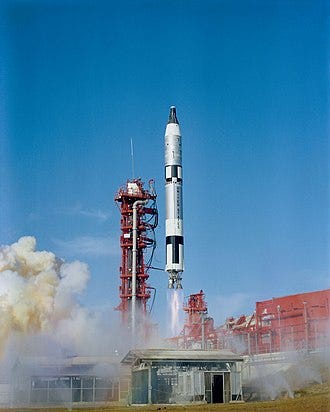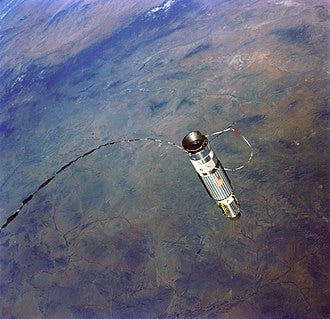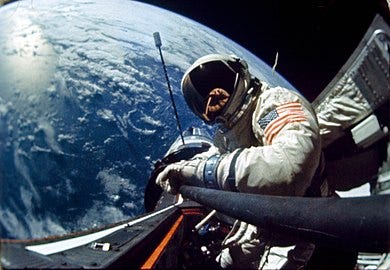November 11, 1966 3:46pm
Crew: Jim Lovell, Buzz Aldrin
Orbits: 59
Duration: 3 days, 22 hours, 34 minutes, 31 seconds
Lovell’s mission, with Buzz Aldrin at his side, began on November 11th, Veterans’ Day. The two astronauts had walked out to Pad 19 with signs on their back. One said, ‘The.’ The other said ‘End.’
At 2:08 pm, the Atlas-Agena lifted-off and was followed ninety-eight minutes later by the Gemini XII’s Titan booster. Communication between the spacecraft and ground control was, with one brief exception, lost for twenty-five minutes. Within an hour after launch, the two spacecraft were just 270 miles apart. But as they approached, the spacecraft’s radar failed. They would have to rely on the backup charts that Aldrin, “Dr. Rendezvous” himself, had created. Using a sextant, Aldrin took the readings and made the calculations that Lovell used to maneuver. Four hours and thirteen minutes after leaving Cape Canaveral, Gemini XII docked with the Agena.
Lovell tried to undock, but the spacecraft were stuck together. Firing his thrusters, Lovell was finally able to break away without damaging either the Gemini or the Agena. Aldrin then was able to dock the vehicles without a problem.
The mission plan called for them to use the Agena to reach high orbit, as had been done on Gemini XI. But a short time after it was launched, the Agena’s main engine had malfunctioned slightly. The ground control team in Houston decided it was too risky to fire the main engine up again.
They did fire up the Agena’s smaller engines, which allowed them to maneuver and spot the total solar eclipse while they flew over South America.
Now it was time for the first of three planned spacewalks by Aldrin. For the first one, he simply opened the hatch and stood up, got used to moving about, and took photographs. He also installed a handrail, a movie camera and retrieved a micrometeorite package. The first spacewalk had lasted two hours and twenty minutes.
The next day it was time for the main event. Aldrin exited the Gemini and used the handrail to pull himself up to the Agena and tied the two spacecraft together. He then pulled himself to the back of the Gemini and slipped his feet into the footholds that been installed there. The restraints worked, giving him the ability to relax and move about without worrying about losing control. He found he was easily able to get the leverage to tighten bolts and cut metal. Moving back to the Agena, he conducted similar tests, pulling electrical connectors apart and then reconnecting them. When he finished, he headed back to his hatch, pausing to wipe the gunk that accumulated on Lovell’s window, something that had been a common problem on previous Gemini missions. “Hey,” Lovell asked him, “would you change the oil, too?”
With Aldrin safely back aboard, Lovell began testing the tether. For about four hours, he struggled to keep the tethered spacecraft under control. But they managed to get some data out of the experiment.
On his final excursion, Aldrin stood up in his seat and, after throwing out unneeded equipment and empty food containers (which would eventually burn up in the atmosphere), Aldrin took another series of photographs.
At this point, the fuel cell that provided electricity to the Gemini began showing signs of failing. By the end of the mission, they had switched to the battery backups.
Coming home, re-entry was again handled by the Gemini’s onboard computer. And once again, it worked almost perfectly and the crew three and a half miles from the recovery ship.
The Gemini Program was now officially over. Within hours after the mission had launched, construction crews began dismantling Pad 19, which would be cut up into scrap iron and sold.
For many working in the space program, this marked a transition. McDonnell, for example, wasn’t active in Apollo until it merged with the Douglas Aircraft Company, which was building the Saturn IVB, which would be used as the second stage of the Saturn IB and third stage of the Saturn V.
“I had decided to go back (to St. Louis),” wrote McDonnell employee Robert Bay. “As I was walking around the facility saying goodbye to friends, one of the Grumman engineers working on the Lunar Module asked if I would consider working with him on the program. Within ten minutes of a quick ‘Yes!’ I was talking with his boss. The following day I was hired as a Lunar Module Environmental Control Systems (ECS) Engineer with a substantial raise included.”
President Lyndon Johnson summarized the next step this way. “The Apollo program which follows is much more complicated,” he said in later November of 1966. “The months ahead will not be easy, as we reach toward the Moon.”
He could not know then how right he was. Apollo 1 was set to liftoff three months later.





